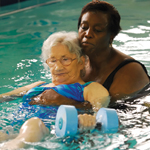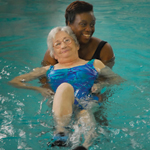 Residents with memory impairments make up the lion’s share of many long term care facilities, but wellness programming continues to suffer from a dichotomy of activities that benefit higher-functioning residents while alienating those needing a heavier standard of care.
Residents with memory impairments make up the lion’s share of many long term care facilities, but wellness programming continues to suffer from a dichotomy of activities that benefit higher-functioning residents while alienating those needing a heavier standard of care.
Senior Living Communities (SLC), a long term care provider based in Charlotte, N.C., is addressing this double standard through the integration of aquatic programming into the framework of its person-centered operating initiatives.
Instead of reinventing the wheel, many communities can benefit from tailoring their resources to fit the needs of their residents. Even the smallest of steps can make a big impact on the quality of care a community delivers.
Utilizing Resources
SLC used this approach to develop a program called Waves, which helps reduce or alleviate symptoms associated with cognitive decline in residents suffering from Alzheimer’s disease and dementia.
Since eight of SLC’s 10 communities have pools for resident use, Vice President of Member Services Kelly Stranburg utilized the community-wide resource as a starting point in the process before testing the program at Summit Hills, a community located in Spartanburg, S.C.
Waves combines the therapeutic benefits of warm water with low-impact aerobic exercise to ease symptoms associated with memory loss such as increased anxiety or wandering behavior. With on-site wellness coordinators leading training sessions under Stranburg’s direction, program implementation was both straightforward and inexpensive.
In conjunction with recently designed “neighborhoods,” where residents benefit from the consistency of assigned caregivers, the Waves program promotes a strong relationship between staff and community members.
“The program is really about personal relationships,” Stranburg says. “That’s why it fits perfectly into our larger, person-centered operating initiatives. Yes, there are physical and emotional benefits, but the amount of trust and understanding required from both caregivers and residents when they get into the water is at the heart of the program’s future success.”
After training, primary caregivers join residents in the pool, guiding them through a variety of slow, methodical exercises.
Despite severe memory loss and the risk of anxiety brought on by strange surroundings, residents benefit from the familiar face of their assigned caregiver, who understands that individual’s preferences and personality.
Positive Results
The benefits residents receive from the activity are well worth the effort, Stranburg says. “Increased activity promotes emotional well-being, improves appetite, reduces stress, and can even help residents rest easier at night. “
Although the short-term objective for Waves is to increase resident engagement and participation while improving self-esteem and personal worth, the long-term objective includes a reduction in the amount of care members need in their everyday lives.
“The idea is not that we reduce care for those who truly need constant monitoring,” Stranburg says. “Rather, we believe residents who require a heavy standard of care should be treated like family members, not hospital patients. If we can reduce their dependence on a caregiver by increasing their physical strength or minimizing anxiety, we can help our residents maintain their dignity throughout an extremely challenging chapter of their lives.”
Compassionate care is at the heart of the Waves program. During training sessions, caregivers are required to play the part of both the assistant and the resident, so they can gain an appreciation for the challenges residents may face when performing the exercises.
Summit Hills Wellness Coordinator Tonya Ray says the program benefits staff members as well as residents. “Caregivers are able to step out of their daily routine and experience something new,” Ray says. “It makes ‘just another day on the job’ something to look forward to.”
The beauty of the program lies in its ability to nurture the whole person while simultaneously strengthening the bond between residents and caregivers. Preliminary results from several of SLC’s communities suggest that Waves is well on its way to breaking ground on a new standard of care.
One Summit Hills resident reports he is “less agitated” after participating in the program, while Ray has observed an increase in lower body strength among participants. Some residents who were unable to stand for long periods of time have been able to improve their mobility and walk for short distances around the community.
Lower body strength and mobility are key determinants when evaluating quality of life and resident independence, Stranburg says. Her goal is to increase or maintain what residents are able to do on their own through their participation in Waves.
The results are measurable and can involve something as simple as being strong enough to don clothing unassisted. Although small, these quality-of-life improvements can make a significant impact on a resident’s self-esteem.

A Team Effort
Using existing resources in an innovative and creative way, SLC was able to introduce a viable, sustainable wellness program to a traditionally underserved population. But, like so many other great ideas, Waves was the result of hard work and research.
The idea of expanding aquatic activities to include memory-care patients was the result of a story Chief Operating Officer Mary Bowers read in an industry publication about a community implementing a similar program.
Moved by the story and the residents’ success, Bowers assembled a team of experts to bring the project
to fruition.
Headed up by Stranburg, who oversees wellness coordinators at all 10 communities, Waves has blossomed into a full-fledged, person-centered example of how wellness programming can improve outcomes for all residents, no matter their individual challenges.
In a year’s time, Stranburg hopes to oversee a total of five Waves programs throughout the system, with the remaining communities coming on board as soon as training is completed. Optimistic about the program’s future success, she encourages other long term care providers to follow suit.
She hopes that others will be inspired by the success of the program. “There is no magic bullet or one-size-fits-all mentality when it comes to person-centered programming for all levels of care,” Stranburg says. “But sharing our success is something we should do, so others can take our ideas and improve the lives of their residents, whether they live with us or not.”
Katie Huffstetler, director of public relations for Senior Living Communities (SLC), Charlotte, N.C., can be reached at khuffstetler@senior-living-communities.com. Kelly Stranburg, M.Ed., CSCS, vice president of member services for SLC, can be reached at kstranburg@senior-living-communities.com.